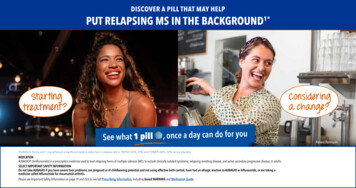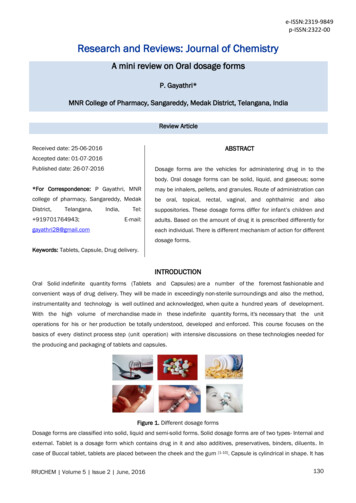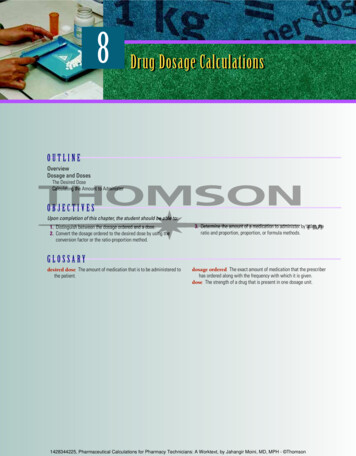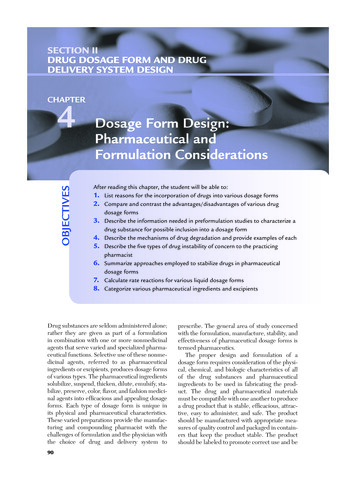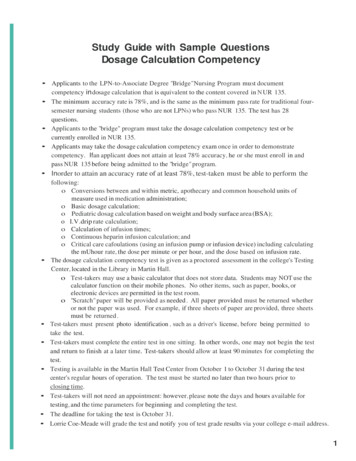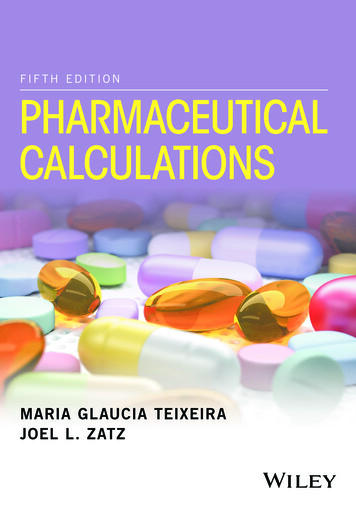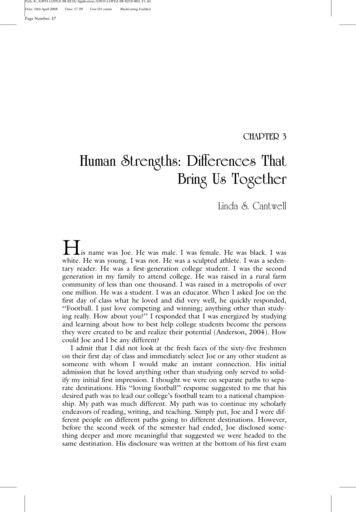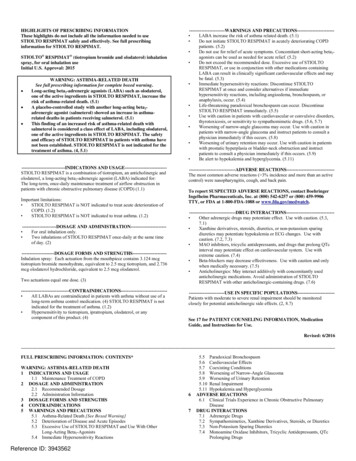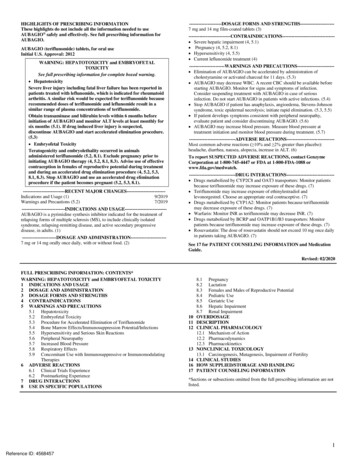
Transcription
HIGHLIGHTS OF PRESCRIBING INFORMATIONThese highlights do not include all the information needed to useAUBAGIO safely and effectively. See full prescribing information forAUBAGIO.AUBAGIO (teriflunomide) tablets, for oral useInitial U.S. Approval: 2012WARNING: HEPATOTOXICITY and EMBRYOFETALTOXICITYSee full prescribing information for complete boxed warning. HepatotoxicitySevere liver injury including fatal liver failure has been reported inpatients treated with leflunomide, which is indicated for rheumatoidarthritis. A similar risk would be expected for teriflunomide becauserecommended doses of teriflunomide and leflunomide result in asimilar range of plasma concentrations of teriflunomide.Obtain transaminase and bilirubin levels within 6 months beforeinitiation of AUBAGIO and monitor ALT levels at least monthly forsix months (5.1). If drug induced liver injury is suspected,discontinue AUBAGIO and start accelerated elimination procedure.(5.3) Embryofetal ToxicityTeratogenicity and embryolethality occurred in animalsadministered teriflunomide (5.2, 8.1). Exclude pregnancy prior toinitiating AUBAGIO therapy (4, 5.2, 8.1, 8.3). Advise use of effectivecontraception in females of reproductive potential during treatmentand during an accelerated drug elimination procedure (4, 5.2, 5.3,8.1, 8.3). Stop AUBAGIO and use an accelerated drug eliminationprocedure if the patient becomes pregnant (5.2, 5.3, 8.1).---------------------------RECENT MAJOR CHANGES------------------------ Indications and Usage (1)9/2019Warnings and Precautions (5.2)7/2019----------------------------INDICATIONS AND USAGE-------------------------- AUBAGIO is a pyrimidine synthesis inhibitor indicated for the treatment ofrelapsing forms of multiple sclerosis (MS), to include clinically isolatedsyndrome, relapsing-remitting disease, and active secondary progressivedisease, in adults. (1)----------------------DOSAGE AND ADMINISTRATION---------------------- 7 mg or 14 mg orally once daily, with or without food. (2)---------------------DOSAGE FORMS AND STRENGTHS--------------------- 7 mg and 14 mg film-coated tablets ------------------------------ Severe hepatic impairment (4, 5.1) Pregnancy (4, 5.2, 8.1) Hypersensitivity (4, 5.5) Current leflunomide treatment (4)-----------------------WARNINGS AND PRECAUTIONS----------------------- Elimination of AUBAGIO can be accelerated by administration ofcholestyramine or activated charcoal for 11 days. (5.3) AUBAGIO may decrease WBC. A recent CBC should be available beforestarting AUBAGIO. Monitor for signs and symptoms of infection.Consider suspending treatment with AUBAGIO in case of seriousinfection. Do not start AUBAGIO in patients with active infections. (5.4) Stop AUBAGIO if patient has anaphylaxis, angioedema, Stevens-Johnsonsyndrome, toxic epidermal necrolysis; initiate rapid elimination. (5.3, 5.5) If patient develops symptoms consistent with peripheral neuropathy,evaluate patient and consider discontinuing AUBAGIO. (5.6) AUBAGIO may increase blood pressure. Measure blood pressure attreatment initiation and monitor blood pressure during treatment. (5.7)------------------------------ADVERSE REACTIONS------------------------------ Most common adverse reactions ( 10% and 2% greater than placebo):headache, diarrhea, nausea, alopecia, increase in ALT. (6)To report SUSPECTED ADVERSE REACTIONS, contact GenzymeCorporation at 1-800-745-4447 or FDA at 1-800-FDA-1088 ---DRUG INTERACTIONS------------------------------ Drugs metabolized by CYP2C8 and OAT3 transporters: Monitor patientsbecause teriflunomide may increase exposure of these drugs. (7) Teriflunomide may increase exposure of ethinylestradiol andlevonorgestrel. Choose an appropriate oral contraceptive. (7) Drugs metabolized by CYP1A2: Monitor patients because teriflunomidemay decrease exposure of these drugs. (7) Warfarin: Monitor INR as teriflunomide may decrease INR. (7) Drugs metabolized by BCRP and OATP1B1/B3 transporters: Monitorpatients because teriflunomide may increase exposure of these drugs. (7) Rosuvastatin: The dose of rosuvastatin should not exceed 10 mg once dailyin patients taking AUBAGIO. (7)See 17 for PATIENT COUNSELING INFORMATION and MedicationGuide.Revised: 02/2020FULL PRESCRIBING INFORMATION: CONTENTS*WARNING: HEPATOTOXICITY and EMBRYOFETAL TOXICITY1 INDICATIONS AND USAGE2 DOSAGE AND ADMINISTRATION3 DOSAGE FORMS AND STRENGTHS4 CONTRAINDICATIONS5 WARNINGS AND PRECAUTIONS5.1 Hepatotoxicity5.2 Embryofetal Toxicity5.3 Procedure for Accelerated Elimination of Teriflunomide5.4 Bone Marrow Effects/Immunosuppression Potential/Infections5.5 Hypersensitivity and Serious Skin Reactions5.6 Peripheral Neuropathy5.7 Increased Blood Pressure5.8 Respiratory Effects5.9 Concomitant Use with Immunosuppressive or ImmunomodulatingTherapies6 ADVERSE REACTIONS6.1 Clinical Trials Experience6.2 Postmarketing Experience7 DRUG INTERACTIONS8 USE IN SPECIFIC POPULATIONS101112131416178.1 Pregnancy8.2 Lactation8.3 Females and Males of Reproductive Potential8.4 Pediatric Use8.5 Geriatric Use8.6 Hepatic Impairment8.7 Renal ImpairmentOVERDOSAGEDESCRIPTIONCLINICAL PHARMACOLOGY12.1 Mechanism of Action12.2 Pharmacodynamics12.3 PharmacokineticsNONCLINICAL TOXICOLOGY13.1 Carcinogenesis, Mutagenesis, Impairment of FertilityCLINICAL STUDIESHOW SUPPLIED/STORAGE AND HANDLINGPATIENT COUNSELING INFORMATION*Sections or subsections omitted from the full prescribing information are notlisted.1Reference ID: 4568457
FULL PRESCRIBING INFORMATIONWARNING: HEPATOTOXICITY and EMBRYOFETAL TOXICITY HepatotoxicitySevere liver injury including fatal liver failure has been reported in patients treatedwith leflunomide, which is indicated for rheumatoid arthritis. A similar risk would beexpected for teriflunomide because recommended doses of teriflunomide andleflunomide result in a similar range of plasma concentrations of teriflunomide.Concomitant use of AUBAGIO with other potentially hepatotoxic drugs may increasethe risk of severe liver injury.Obtain transaminase and bilirubin levels within 6 months before initiation ofAUBAGIO therapy. Monitor ALT levels at least monthly for six months after startingAUBAGIO [see Warnings and Precautions (5.1)]. If drug induced liver injury issuspected, discontinue AUBAGIO and start an accelerated elimination procedure withcholestyramine or charcoal [see Warnings and Precautions (5.3)]. AUBAGIO iscontraindicated in patients with severe hepatic impairment [see Contraindications (4)].Patients with pre-existing liver disease may be at increased risk of developing elevatedserum transaminases when taking AUBAGIO. Embryofetal ToxicityAUBAGIO is contraindicated for use in pregnant women and in females ofreproductive potential who are not using effective contraception because of thepotential for fetal harm. Teratogenicity and embryolethality occurred in animals atplasma teriflunomide exposures lower than that in humans. Exclude pregnancy beforethe start of treatment with AUBAGIO in females of reproductive potential. Advisefemales of reproductive potential to use effective contraception during AUBAGIOtreatment and during an accelerated drug elimination procedure after AUBAGIOtreatment. Stop AUBAGIO and use an accelerated drug elimination procedure if thepatient becomes pregnant [see Contraindications (4), Warnings and Precautions (5.2,5.3), Use in Specific Populations (8.1, 8.3), and Clinical Pharmacology (12.3)].1INDICATIONS AND USAGEAUBAGIO is indicated for the treatment of relapsing forms of multiple sclerosis (MS), toinclude clinically isolated syndrome, relapsing-remitting disease, and active secondaryprogressive disease, in adults.2DOSAGE AND ADMINISTRATIONThe recommended dose of AUBAGIO is 7 mg or 14 mg orally once daily. AUBAGIO can betaken with or without food.Monitoring to Assess Safety Obtain transaminase and bilirubin levels within 6 months before initiation of AUBAGIOtherapy. Monitor ALT levels at least monthly for six months after starting AUBAGIO [seeWarnings and Precautions (5.1)].2Reference ID: 4568457
Obtain a complete blood cell count (CBC) within 6 months before the initiation of treatmentwith AUBAGIO. Further monitoring should be based on signs and symptoms of infection[see Warnings and Precautions (5.4)]. Prior to initiating AUBAGIO, screen patients for latent tuberculosis infection with atuberculin skin test or blood test for mycobacterium tuberculosis infection [see Warnings andPrecautions (5.4)]. Exclude pregnancy prior to initiation of treatment with AUBAGIO in females ofreproductive potential [see Warnings and Precautions (5.2)]. Check blood pressure before start of AUBAGIO treatment and periodically thereafter [seeWarnings and Precautions (5.7)].3DOSAGE FORMS AND STRENGTHSAUBAGIO is available as 7 mg and 14 mg tablets.The 14 mg tablet is a pale blue to pastel blue, pentagonal film-coated tablet with the dosestrength “14” imprinted on one side and engraved with the corporate logo on the other side. Eachtablet contains 14 mg of teriflunomide.The 7 mg tablet is a very light greenish-bluish grey to pale greenish-blue, hexagonal film-coatedtablet with the dose strength “7” imprinted on one side and engraved with the corporate logo onother side. Each tablet contains 7 mg of teriflunomide.4CONTRAINDICATIONSAUBAGIO is contraindicated in/with: Patients with severe hepatic impairment [see Warnings and Precautions (5.1)]. Pregnant women and females of reproductive potential not using effective contraception.AUBAGIO may cause fetal harm [see Warnings and Precautions (5.2, 5.3) and Use inSpecific Populations (8.1)]. Patients with a history of a hypersensitivity reaction to teriflunomide, leflunomide, or toany of the inactive ingredients in AUBAGIO. Reactions have included anaphylaxis,angioedema, and serious skin reactions [see Warnings and Precautions (5.5)]. Coadministration with leflunomide [see Clinical Pharmacology (12.3)].5WARNINGS AND PRECAUTIONS5.1HepatotoxicitySevere liver injury including fatal liver failure and dysfunction has been reported in somepatients treated with leflunomide, which is indicated for rheumatoid arthritis. A similar riskwould be expected for teriflunomide because recommended doses of teriflunomide andleflunomide result in a similar range of plasma concentrations of teriflunomide. Patients withpre-existing liver disease may be at increased risk of developing elevated serum transaminaseswhen taking AUBAGIO. Patients with pre-existing acute or chronic liver disease, or those withserum alanine aminotransferase (ALT) greater than two times the upper limit of normal (ULN)3Reference ID: 4568457
before initiating treatment, should not normally be treated with AUBAGIO. AUBAGIO iscontraindicated in patients with severe hepatic impairment [see Contraindications (4)].In placebo-controlled trials, ALT greater than three times the ULN occurred in 61/1045 (5.8%)and 62/1002 (6.2%) of patients receiving AUBAGIO 7 mg and 14 mg, respectively, and 38/997(3.8%) of patients receiving placebo, during the treatment period. These elevations occurredmostly within the first year of treatment. Half of the cases returned to normal without drugdiscontinuation. In clinical trials, if ALT elevation was greater than three times the ULN on twoconsecutive tests, AUBAGIO was discontinued and patients underwent an acceleratedelimination procedure [see Warnings and Precautions (5.3)]. Of the patients who underwentdiscontinuation and accelerated elimination in controlled trials, half returned to normal or nearnormal values within 2 months.One patient in the controlled trials developed ALT 32 times the ULN and jaundice 5 monthsafter initiation of AUBAGIO 14 mg treatment. The patient was hospitalized for 5 weeks andrecovered after plasmapheresis and cholestyramine accelerated elimination procedure.AUBAGIO-induced liver injury in this patient could not be ruled out.Obtain serum transaminase and bilirubin levels within 6 months before initiation of AUBAGIOtherapy. Monitor ALT levels at least monthly for six months after starting AUBAGIO. Consideradditional monitoring when AUBAGIO is given with other potentially hepatotoxic drugs.Consider discontinuing AUBAGIO if serum transaminase increase (greater than three times theULN) is confirmed. Monitor serum transaminase and bilirubin on AUBAGIO therapy,particularly in patients who develop symptoms suggestive of hepatic dysfunction, such asunexplained nausea, vomiting, abdominal pain, fatigue, anorexia, or jaundice and/or dark urine.If liver injury is suspected to be AUBAGIO-induced, discontinue AUBAGIO and start anaccelerated elimination procedure [see Warnings and Precautions (5.3)] and monitor liver testsweekly until normalized. If AUBAGIO-induced liver injury is unlikely because some otherprobable cause has been found, resumption of AUBAGIO therapy may be considered.5.2Embryofetal ToxicityAUBAGIO may cause fetal harm when administered to a pregnant woman. Teratogenicity andembryofetal lethality occurred in animal reproduction studies in multiple animal species atplasma teriflunomide exposures similar to or lower than that in humans at the maximumrecommended human dose (MRHD) of 14 mg/day [see Use in Specific Populations (8.1)].AUBAGIO is contraindicated for use in pregnant women and in females of reproductivepotential not using effective contraception [see Contraindications (4)]. Exclude pregnancybefore starting treatment with AUBAGIO in females of reproductive potential [see Dosage andAdministration (2)]. Advise females of reproductive potential to use effective contraceptionduring AUBAGIO treatment and during an accelerated drug elimination procedure afterAUBAGIO treatment [see Use in Specific Populations (8.3)]. If a woman becomes pregnantwhile taking AUBAGIO, stop treatment with AUBAGIO, apprise the patient of the potential riskto a fetus, and perform an accelerated drug elimination procedure to achieve a plasmateriflunomide concentration of less than 0.02 mg/L [see Warnings and Precautions (5.3)].Upon discontinuing AUBAGIO, it is recommended that all females of reproductive potentialundergo an accelerated drug elimination procedure. Women receiving AUBAGIO treatment whowish to become pregnant must discontinue AUBAGIO and undergo an accelerated drug4Reference ID: 4568457
elimination procedure, which includes verification that plasma concentrations of teriflunomideare less than 0.02 mg/L (0.02 mcg/mL). Men wishing to father a child should also discontinueuse of AUBAGIO and either undergo an accelerated elimination procedure or wait untilverification that the plasma teriflunomide concentration is less than 0.02 mg/L (0.02 mcg/mL)[see Use in Specific Population (8.3)]. Based on animal data, human plasma concentrations ofteriflunomide of less than 0.02 mg/L (0.02 mcg/mL) are expected to have minimal embryofetalrisk [see Contraindications (4), Warnings and Precautions (5.3), and Use in SpecificPopulations (8.1)].5.3Procedure for Accelerated Elimination of TeriflunomideTeriflunomide is eliminated slowly from the plasma [see Clinical Pharmacology (12.3)].Without an accelerated elimination procedure, it takes on average 8 months to reach plasmaconcentrations less than 0.02 mg/L, although because of individual variations in drug clearance itmay take as long as 2 years. An accelerated elimination procedure could be used at any time afterdiscontinuation of AUBAGIO. Elimination can be accelerated by either of the followingprocedures: Administration of cholestyramine 8 g every 8 hours for 11 days. If cholestyramine 8 gthree times a day is not well tolerated, cholestyramine 4 g three times a day can be used. Administration of 50 g oral activated charcoal powder every 12 hours for 11 days.If either elimination procedure is poorly tolerated, treatment days do not need to be consecutiveunless there is a need to lower teriflunomide plasma concentration rapidly.At the end of 11 days, both regimens successfully accelerated teriflunomide elimination, leadingto more than 98% decrease in teriflunomide plasma concentrations.Use of the accelerated elimination procedure may potentially result in return of disease activity ifthe patient had been responding to AUBAGIO treatment.5.4Bone Marrow Effects/Immunosuppression Potential/InfectionsBone Marrow EffectsA mean decrease compared to baseline in white blood cell (WBC) count of approximately 15%(mainly neutrophils and lymphocytes) and in platelet count of approximately 10% was observedin placebo-controlled trials with 7 mg and 14 mg of AUBAGIO. The decrease in mean WBCcount occurred during the first 6 weeks and WBC count remained low during treatment. Inplacebo-controlled studies, neutrophil count 1.5 109/L was observed in 12% and 16% ofpatients receiving AUBAGIO 7 mg and 14 mg, respectively, compared with 7% of patientsreceiving placebo; lymphocyte count 0.8 109/L was observed in 10% and 12% of patientsreceiving AUBAGIO 7 mg and 14 mg, respectively, compared with 6% of patients receivingplacebo. No cases of serious pancytopenia were reported in premarketing clinical trials ofAUBAGIO but rare cases of pancytopenia and agranulocytosis have been reported in thepostmarketing setting with leflunomide. A similar risk would be expected for AUBAGIO [seeClinical Pharmacology (12.3)]. Cases of thrombocytopenia with AUBAGIO, including rarecases with platelet counts less than 50,000/mm3, have been reported in the postmarketing setting.Obtain a complete blood cell count (CBC) within 6 months before the initiation of treatment withAUBAGIO. Further monitoring should be based on signs and symptoms suggestive of bonemarrow suppression.5Reference ID: 4568457
Risk of Infection/Tuberculosis ScreeningPatients with active acute or chronic infections should not start treatment until the infection(s) isresolved. If a patient develops a serious infection consider suspending treatment with AUBAGIOand using an accelerated elimination procedure. Reassess the benefits and risks prior toresumption of therapy. Instruct patients receiving AUBAGIO to report symptoms of infections toa physician.AUBAGIO is not recommended for patients with severe immunodeficiency, bone marrowdisease, or severe, uncontrolled infections. Medications like AUBAGIO that haveimmunosuppression potential may cause patients to be more susceptible to infections, includingopportunistic infections.In placebo-controlled studies of AUBAGIO, no overall increase in the risk of serious infectionswas observed with AUBAGIO 7 mg (2.2%) or 14 mg (2.7%) compared to placebo (2.2%).However, one fatal case of klebsiella pneumonia sepsis occurred in a patient taking AUBAGIO14 mg for 1.7 years. Fatal infections have been reported in the postmarketing setting in patientsreceiving leflunomide, especially Pneumocystis jirovecii pneumonia and aspergillosis. Most ofthe reports were confounded by concomitant immunosuppressant therapy and/or comorbidillness which, in addition to rheumatoid disease, may predispose patients to infection. In clinicalstudies with AUBAGIO, cytomegalovirus hepatitis reactivation has been observed.In clinical studies with AUBAGIO, cases of tuberculosis have been observed. Prior to initiatingAUBAGIO, screen patients for latent tuberculosis infection with a tuberculin skin test or with ablood test for mycobacterium tuberculosis infection. AUBAGIO has not been studied in patientswith a positive tuberculosis screen, and the safety of AUBAGIO in individuals with latenttuberculosis infection is unknown. For patients testing positive in tuberculosis screening, treat bystandard medical practice prior to therapy with AUBAGIO.VaccinationNo clinical data are available on the efficacy and safety of live vaccinations in patients takingAUBAGIO. Vaccination with live vaccines is not recommended. The long half-life ofAUBAGIO should be considered when contemplating administration of a live vaccine afterstopping AUBAGIO.MalignancyThe risk of malignancy, particularly lymphoproliferative disorders, is increased with the use ofsome immunosuppressive medications. There is a potential for immunosuppression withAUBAGIO. No apparent increase in the incidence of malignancies and lymphoproliferativedisorders was reported in the AUBAGIO clinical trials, but larger and longer-term studies wouldbe needed to determine whether there is an increased risk of malignancy or lymphoproliferativedisorders with AUBAGIO.5.5Hypersensitivity and Serious Skin ReactionsAUBAGIO can cause anaphylaxis and severe allergic reactions [see Contraindications (4)].Signs and symptoms have included dyspnea, urticaria, and angioedema including lips, eyes,throat, and tongue.6Reference ID: 4568457
Cases of serious skin reactions, including cases of Stevens-Johnson syndrome (SJS) and a fatalcase of toxic epidermal necrolysis (TEN), have been reported with AUBAGIO.In patients treated with leflunomide, the parent compound, very rare cases of Drug Reaction withEosinophilia and Systemic Symptoms (DRESS) have also been reported.Inform patients of the signs and symptoms of anaphylaxis and angioedema and signs andsymptoms that may signal a serious skin reaction. Inform patients that a fever associated withsigns of other organ system involvement (e.g., rash, lymphadenopathy, or hepatic dysfunction)may be drug-related. Instruct patients to discontinue AUBAGIO and seek immediate medicalcare should these signs and symptoms occur. Discontinue AUBAGIO, unless the reactions areclearly not drug-related, and begin an accelerated elimination procedure immediately [seeWarnings and Precautions (5.3)]. In such cases, patients should not be re-exposed toteriflunomide [see Contraindications (4)].5.6Peripheral NeuropathyIn placebo-controlled studies, peripheral neuropathy, including both polyneuropathy andmononeuropathy (e.g., carpal tunnel syndrome), occurred more frequently in patients takingAUBAGIO than in patients taking placebo. The incidence of peripheral neuropathy confirmed bynerve conduction studies was 1.4% (13 patients) and 1.9% (17 patients) of patients receiving 7mg and 14 mg of AUBAGIO, respectively, compared with 0.4% receiving placebo (4 patients).Treatment was discontinued in 0.7% (8 patients) with confirmed peripheral neuropathy (3patients receiving AUBAGIO 7 mg and 5 patients receiving AUBAGIO 14 mg). Five of themrecovered following treatment discontinuation. Not all cases of peripheral neuropathy resolvedwith continued treatment. Peripheral neuropathy also occurred in patients receiving leflunomide.Age older than 60 years, concomitant neurotoxic medications, and diabetes may increase the riskfor peripheral neuropathy. If a patient taking AUBAGIO develops symptoms consistent withperipheral neuropathy, such as bilateral numbness or tingling of hands or feet, considerdiscontinuing AUBAGIO therapy and performing an accelerated elimination procedure [seeWarnings and Precautions (5.3)].5.7Increased Blood PressureIn placebo-controlled studies, the mean change from baseline to the end of study in systolicblood pressure was 2.3 mmHg and 2.7 mmHg for AUBAGIO 7 mg and 14 mg, respectively,and -0.6 mmHg for placebo. The change from baseline in diastolic blood pressure was 1.4mmHg and 1.9 mmHg for AUBAGIO 7 mg and 14 mg, respectively, and -0.3 mmHg forplacebo. Hypertension was an adverse reaction in 3.1% and 4.3% of patients treated with 7 mg or14 mg of AUBAGIO compared with 1.8% for placebo. Check blood pressure before start ofAUBAGIO treatment and periodically thereafter. Elevated blood pressure should beappropriately managed during treatment with AUBAGIO.5.8Respiratory EffectsInterstitial lung disease, including acute interstitial pneumonitis, has been reported withAUBAGIO in the postmarketing setting.Interstitial lung disease and worsening of pre-existing interstitial lung disease have been reportedduring treatment with leflunomide. Interstitial lung disease may be fatal and may occur acutely atany time during therapy with a variable clinical presentation. New onset or worsening pulmonary7Reference ID: 4568457
symptoms, such as cough and dyspnea, with or without associated fever, may be a reason fordiscontinuation of therapy and for further investigation as appropriate. If discontinuation of thedrug is necessary, consider initiation of an accelerated elimination procedure [see Warnings andPrecautions (5.3)].5.9Concomitant Use with Immunosuppressive or ImmunomodulatingTherapiesCoadministration with antineoplastic or immunosuppressive therapies used for treatment ofmultiple sclerosis has not been evaluated. Safety studies in which AUBAGIO was concomitantlyadministered with other immune modulating therapies for up to one year (interferon beta,glatiramer acetate) did not reveal any specific safety concerns. The long term safety of thesecombinations in the treatment of multiple sclerosis has not been established.In any situation in which the decision is made to switch from AUBAGIO to another agent with aknown potential for hematologic suppression, it would be prudent to monitor for hematologictoxicity, because there will be overlap of systemic exposure to both compounds. Use of anaccelerated elimination procedure may decrease this risk, but may also potentially result in returnof disease activity if the patient had been responding to AUBAGIO treatment [see Warnings andPrecautions (5.3)].6ADVERSE REACTIONSThe following serious adverse reactions are described elsewhere in the prescribing information: Hepatotoxicity [see Contraindications (4) and Warnings and Precautions (5.1)] Bone Marrow Effects/Immunosuppression Potential/Infections [see Warnings andPrecautions (5.4)] Hypersensitivity and Serious Skin Reactions [see Contraindications (4) and Warningsand Precautions (5.5)] Peripheral Neuropathy [see Warnings and Precautions (5.6)] Increased Blood Pressure [see Warnings and Precautions (5.7)] Respiratory Effects [see Warnings and Precautions (5.8)]6.1Clinical Trials ExperienceBecause clinical trials are conducted under widely varying conditions, adverse reaction ratesobserved in the clinical trials of a drug cannot be directly compared to rates in the clinical trialsof another drug and may not reflect the rates observed in clinical practice.A total of 2047 patients receiving AUBAGIO (7 mg or 14 mg once daily) constituted the safetypopulation in the pooled analysis of placebo controlled studies in patients with relapsing forms ofmultiple sclerosis; of these, 71% were female. The average age was 37 years.Table 1 lists adverse reactions in placebo-controlled trials with rates that were at least 2% forAUBAGIO patients and also at least 2% above the rate in placebo patients. The most commonwere headache, an increase in ALT, diarrhea, alopecia, and nausea. The adverse reaction mostcommonly associated with discontinuation was an increase in ALT (3.3%, 2.6%, and 2.3% of allpatients in the AUBAGIO 7 mg, AUBAGIO 14 mg, and placebo treatment arms, respectively).8Reference ID: 4568457
Table 1: Adverse Reactions in Pooled Placebo-Controlled Studies in Patients withRelapsing Forms of Multiple SclerosisAdverse ReactionHeadacheIncrease in Alanine rthralgiaNeutropeniaHypertensionAUBAGIO7 mg(N 1045)18%13%13%10%8%8%AUBAGIO14 mg(N 1002)16%15%14%13%11%9%Placebo(N 997)15%9%8%5%7%7%8%4%3%6%6%4%5%2%2%Cardiovascular DeathsFour cardiovascular deaths, including three sudden deaths, and one myocardial infarction in apatient with a history of hyperlipidemia and hypertension were reported among approximately2600 patients exposed to AUBAGIO in the premarketing database. These cardiovascular deathsoccurred during uncontrolled extension studies, one to nine years after initiation of treatment. Arelationship between AUBAGIO and cardiovascular death has not been established.Acute Renal FailureIn placebo-controlled studies, creatinine values increased more than 100% over baseline in8/1045 (0.8%) patients in the 7 mg AUBAGIO group and 6/1002 (0.6%) patients in the 14 mgAUBAGIO group versus 4/997 (0.4%) patients in the placebo group. These elevations weretransient. Some elevations were accompanied by hyperkalemia. AUBAGIO may cause acute uricacid nephropathy with transient acute renal failure because AUBAGIO increases renal uric acidclearance.HypophosphatemiaIn clinical trials, 18% of AUBAGIO-treated patients had hypophosphatemia with serumphosphorus levels of at least 0.6 mmol/L, compared to 7% of placebo-treated patients; 4% ofAUBAGIO-treated patients had hypophosphatemia with serum phosphorus levels at least 0.3mmol/L but less than 0.6 mmol/L, compared to 0.8% of placebo-treated patients. No patient inany treatment group had a serum phosphorus below 0.3 mmol/L.6.2Postmarketing ExperienceThe following adverse reactions have been identified during postapproval use of AUBAGIO.Because these reactions are reported voluntarily from a population of uncertain size, it is notalways possible to reliably estimate their frequency or establish a causal relationship to drugexposure. Hypersensitivity reactions, some of which were severe, such as anaphylaxis and angioedema[see Warnings and Precautions (5.5)]9Reference ID: 4568457
Severe skin reactions, including toxic epidermal necrolysis and Stevens-Johnson syndrome[see Warnings and Precautions (5.5)] Psoriasis or worsening of psoriasis (including pustular psoriasis) Thrombocytopenia [see Warnings and Precautions (5.4)] Interstitial lung disease [see Warnings and Precautions (5.8)] Pancreatitis7DRUG INTERACTIONSEffect of AUBAGIO on CYP2C8 SubstratesTeriflunomide is an inhibitor of CYP2C8 in vivo. In patients taking AUBAGIO, exposure ofdrugs metabolized by CYP2C8 (e.g., paclitaxel, pioglitazone, repaglinide, rosiglitazone) may beincreased. Monitor these patients and adjust the dose of the concomitant drug(s) metabolized byCYP2C8 as required [see Clinical Pharmacology (12.3)].Effect of AUBAGIO on WarfarinCoadministrati
ULN) is confirmed. Monitor serum transaminase and bilirubin on AUBAGIO therapy, particularly in patients who develop symptoms suggestive of hepatic dysfunction, such as unexplained nausea, vomiting, abdominal pain, fatigue, anorexia, or jaundice and/or dark urine. If liver injury is suspected to be AUBAGIO-induced, discontinue AUBAGIO and start an
